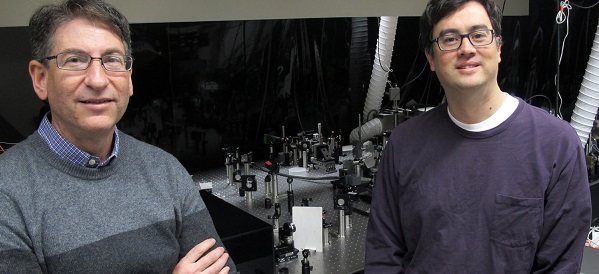Four pulses of laser light on nanoparticle photocells in a University of Oregon spectroscopy experiment has opened a window on how captured sunlight can be converted into electricity.
The work, which potentially could inspire devices with improved efficiency in solar energy conversion, was performed on photocells that used lead-sulfide quantum dots as photoactive semiconductor material. The research is detailed in a paper placed online by the journal Nature Communications.
In the process studied, each single photon, or particle of sunlight, that is absorbed potentially creates multiple packets of energy called excitons. These packets can subsequently generate multiple free electrons that generate electricity in a process known as multiple exciton generation (MEG). In most solar cells, each absorbed photon creates just one potential free electron.
Multiple exciton generation is of interests because it can lead to solar cells that generate more electrical current and make them more efficient. The UO work shines new light on the little understood process of MEG in nanomaterials.
While the potential importance of MEG in solar energy conversion is under debate by scientists, the UO spectroscopy experiment — adapted in a collaboration with scientists at Sweden’s Lund University — should be useful for studying many other processes in photovoltaic nanomaterials, said Andrew H. Marcus, professor of physical chemistry and head of the UO Department of Chemistry and Biochemistry.
Spectroscopic experiments previously designed by Marcus to perform two-dimensional fluorescence spectroscopy of biological molecules were adapted to also measure photocurrent. “Spectroscopy is all about light and molecules and what they do together,” Marcus said. “It is a really great probe that helps to tell us about the reaction pathway that connects the beginning of a chemical or physical process to its end.
“The approach is similar to looking at how molecules come together in DNA, but instead we looked at interactions within semiconductor materials,” said Marcus, an affiliate in UO’s Institute of Molecular Biology, Materials Science Institute and Oregon Center for Optics. “Our method made it possible to look at electronic pathways involved in creating multiple excitons. The existence of this phenomenon had only been inferred through indirect evidence. We believe we have seen the initial steps that lead to MEG-mediated photo conductivity.”
The controlled sequencing of laser pulses allowed the seven-member research team to see — in femtoseconds (a femtosecond is one millionth of one billionth of a second) — the arrival of light, its interaction with resting electrons and the subsequent conversion into multiple excitons. The combined use of photocurrent and fluorescence two-dimensional spectroscopy, Marcus said, provided complementary information about the reaction pathway.
UO co-author Mark C. Lonergan, professor of physical and materials chemistry, who studies electrical and electrochemical phenomena in solid-state systems, likened the processes being observed to people moving through a corn maze that has one entrance and three exits.
People entering the maze are photons. Those who exit quickly represent absorbed photons that generate unusable heat. People leaving the second exit represent other absorbed photons that generate fluorescence but not usable free electrons. People leaving the final exit signify usable electrical current.
“The question we are interested in is exactly what does the maze look like,” Lonergan said. “The problem is we don’t have good techniques to look inside the maze to discover the possible pathways through it. The techniques that Andy has developed basically allow us to see into the maze by encoding what is coming out of the system in terms of exactly what is going in. We can visualize what is going on, whether two people coming into the maze shook hands at some point and details about the pathway that led them to come out the electricity exit.”
The project began when Tonu Pullerits, who studies ultrafast photochemistry in semiconductor molecular materials at Lund University, approached Marcus about adopting his spectroscopic system to look at solar materials. Khadga J. Karki, a postdoctoral researcher in Pullerits’ lab, then visited the UO and teamed with the Marcus and Lonergan groups to reconfigure the equipment.
UO doctoral student Julia R. Widom was a co-leading author on the paper. Other co-authors with Pullerits, Marcus and Lonergan were Joachim Seibt of Lund University and UO graduate student Ian Moody.
The National Science Foundation (grant CHE-1307272 to Marcus) and U.S. Department of Energy (grant DE-SC0012363 to Lonergan) supported the project. The Wenner-Gren Foundation, Knut and Alice Wallenberg Foundation, Swedish Foundation for International Cooperation in Research and Higher Education, Swedish Energy Agency and Swedish Research Council funded the Lund University researchers.
Publication Reference:
Khadga J. Karki, Julia R. Widom, Joachim Seibt, Ian Moody, Mark C. Lonergan, Tõnu Pullerits, Andrew H. Marcus. Coherent two-dimensional photocurrent spectroscopy in a PbS quantum dot photocell. Nature Communications, 2014
Article Source:
Oregon researchers glimpse pathway of sunlight to electricity; University of Oregon — December 18, 2014












Comments